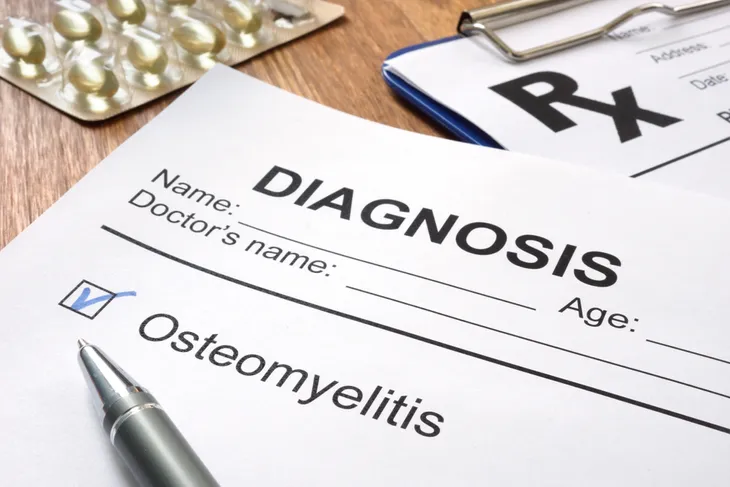Maintaining proper hygiene and diligently disinfecting communal exercise spaces is about more than being courteous. Stopping the potential spread of harmful germs and bacteria can save a lot of people a whole lot of serious health complications.
It can appear seemingly out of the blue, and affect even the healthiest of us, but what exactly is osteomyelitis? Today, we’re going to take a closer look at this unpleasant condition, educate you on all of its potential signs, and break down all of the things that you can do right now to prevent it from impacting your life.
What Is Osteomyelitis?
Osteomyelitis causes inflammation or swelling of bone tissue and is usually the result of an infection of the bone. This can happen in several different ways. A bacterial bloodstream infection can spread to the bone, a traumatic injury can spread the infection to the bone, or an individual with a weakened immune system can develop it.
Once thought to be incurable, osteomyelitis can be treated with help from a professional. In some cases, treatment may be life-long, and complications can lead to frequent fractures of the affected bone, stunted growth in children, and gangrene.
Signs & Symptoms of Osteomyelitis
There is a wide swath of symptoms, and not all of them are easy to spot. Signs of osteomyelitis may include fever, pain, or tenderness in the affected area, feeling ill, swelling, redness, difficulty moving joints, a stiff back, and sometimes warmth in the affected area. In infants, osteomyelitis may present as irritability.
Symptoms for acute and chronic osteomyelitis are similar but an acute infection typically develops rapidly over a period of 7 to 10-days.
Causes
Osteomyelitis can occur in otherwise healthy individuals in several different ways. Most of the time, osteomyelitis develops due to exposure to the Staphylococcus bacteria. These bacteria are everywhere, but they can sometimes lead to serious bacterial infections on the surface of the skin, as well as internally.
Osteomyelitis can occur if these dangerous bacteria travel through the bloodstream to a weakened spot in the bone. Injuries, including severe puncture wounds, are also an entry point for bacteria to reach nearby bones. Finally, direct contamination to the bone because of surgeries to replace joints or fix fractures may lead to bone infections too.
Risk Factors
It’s true, this painful condition can present itself in even the healthiest individuals. There are a few factors that may increase your risk of encountering osteomyelitis.
Anyone who has recently suffered a severe bone fracture, a deep puncture wound, or has undergone a recent orthopedic surgery is at an increased risk. Those suffering from circulation disorders, including diabetes, peripheral artery disease, or sickle cell disease, have a higher risk as well. Illicit drug use, problems that require intravenous lines or catheters, and immunocompromised individuals are also all at higher risk of osteomyelitis.
How Does Osteomyelitis Affect Children and Adults?
Osteomyelitis can affect children and adults differently. Children usually experience acute osteomyelitis which means it can come on quickly. It also means it’s usually easier to treat and typically has a better outlook, says WebMD. Children also mostly develop the infection in the arm or leg bones.
In contrast, adults may experience acute or chronic osteomyelitis. Diabetes, HIV, and peripheral vascular disease are all factors that can increase your chances of developing chronic osteomyelitis. Adults typically develop (acute or chronic) osteomyelitis in the pelvis, vertebrae of the spine, and sometimes the feet (especially in individuals with diabetes).
When to See a Doctor
You should seek immediate medical attention if your symptoms of bone pain continue to worsen, or if a pre-existing medical condition or recent surgery or injury has increased your risk of developing an infection.
At your appointment, your doctor will likely ask you a variety of questions. Some of these may include when did you start experiencing symptoms, does anything help your symptoms improve (or make them worse), have you had any injuries or surgeries lately, and more. Write down as much as you can to provide your doctor with as much information as possible.
How Is Osteomyelitis Diagnosed?
If you notice symptoms of osteomyelitis, connect with your doctor to get screened. To diagnose osteomyelitis, your doctor will first perform a physical exam. They’ll be looking for pain, swelling, and discoloration.
Healthline says your doctor may also request a diagnostic test in order to determine the extent of the infection, as well as the location. Further, your doctor may also order a blood test that checks for the type of organisms causing your infection.
Other Possible Tests
Other possible diagnostic tests include throat swabs, urine cultures, or a stool analysis which all help determine what bacteria is causing your infection.
Your doctor may also require a bone scan, MRI, X-ray, or a bone biopsy to determine the extent of your infection. These tests not only help your doctor diagnose osteomyelitis, but will also help them determine the right course of treatment.
Treatment: Antibiotics
Once diagnosed, your doctor will set out to stop the infection as quickly and as effectively as possible. This is done with antibiotics, surgery, or a combination of both.
Antibiotics may be the only treatment you need to cure osteomyelitis and you may need to take them for up to 6-weeks. In some cases when the infection is severe, your doctor may administer them intravenously.
Treatment: Surgery
Sometimes, antibiotics won’t be enough to treat the infection. In these cases, surgery may be necessary. During surgery, your surgeon will remove the infected bone and drain any abscesses.
If surgery, and antibiotics fail, amputation may be necessary to prevent the infection from spreading to other parts of the body.
What Is the Outlook for Osteomyelitis?
The good news is, osteomyelitis is often treatable. That said, chronic cases may take longer to treat and heal. This is especially true if you require surgery as a part of your treatment.
Healthline says, “treatment should be aggressive because an amputation can become necessary sometimes.” Thankfully, the overall outlook is promising, especially with early intervention.
Prevention
Prevention is a matter of keeping things clean. If you or a dependent has a cut, it’s critical that you wash it completely. Start by running it under water for 5-minutes, then bandage it with sterile bandages that are changed regularly.
Preventing and treating osteomyelitis is a matter of keeping wounds clean and seeking out medical treatment as soon as possible. Do not hesitate to seek medical care. It could be the difference between a minor prescription to antibiotics and life-altering surgery.















